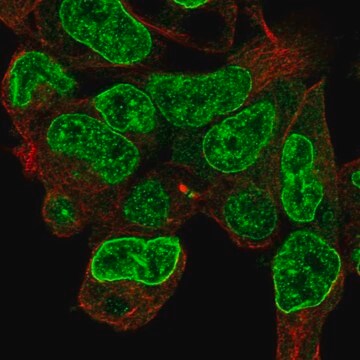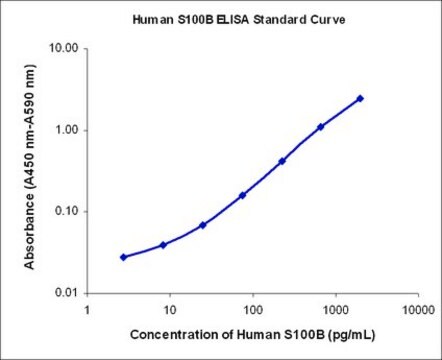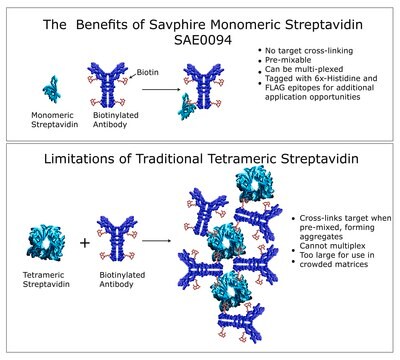T1192
Anti-Thymine Dimer antibody, Mouse monoclonal
clone H3, purified from hybridoma cell culture
Autenticatiper visualizzare i prezzi riservati alla tua organizzazione & contrattuali
About This Item
Numero MDL:
Codice UNSPSC:
12352203
Prodotti consigliati
Origine biologica
mouse
Livello qualitativo
Coniugato
unconjugated
Forma dell’anticorpo
purified immunoglobulin
Tipo di anticorpo
primary antibodies
Clone
H3, monoclonal
Stato
buffered aqueous solution
Reattività contro le specie
chicken, wide range
Confezionamento
antibody small pack of 25 μL
Concentrazione
~2 mg/mL
tecniche
capture ELISA: suitable
dot blot: 0.5-1 μg/mL
immunocytochemistry: suitable
Isotipo
IgG1
Condizioni di spedizione
dry ice
Temperatura di conservazione
−20°C
modifica post-traduzionali bersaglio
unmodified
Categorie correlate
Descrizione generale
UV light induces the formation of thymine dimers that subsequently leads to DNA damage in cells. Monoclonal antibodies that bind to thymine dimers enable the study of cell death and UV-induced DNA damage during photocarcinogenesis . Monoclonal Anti-Thymine Dimer binds to the (5′-6′) cyclobutane type of homothymine or thyminecytosine heterodimers in single-stranded DNA. The antibody has a decreased affinity for the dimer in short oligonucleotides (an oligonucleotide of atleast 10-20 thymine residues is required for the labeling of the probes). The product facilitates the use of a sensitive and non-radioactive technique for the analysis of thymine dimerization.
Immunogeno
tetra nucleotide containing cyclobutane thymine dimer (GTTG) conjugated to chicken gamma globulin.
Applicazioni
May be used in Southern blotting at 0.5-1μg/mL using UV induced thymine dimers of λ phage DNA fragments.
Monoclonal Anti-Thymine Dimer antibody is suitable for use in dot blot (0.5-1 mg/mL), immunocytochemistry (1:100) and capture ELISA.
Stato fisico
Solution in 0.01 M phosphate buffered saline, pH 7.4, containing 15 mM sodium azide.
Altre note
Distributed under license.
Patents WO87/01134, EP 0233 177 B1
Patents WO87/01134, EP 0233 177 B1
Esclusione di responsabilità
Unless otherwise stated in our catalog or other company documentation accompanying the product(s), our products are intended for research use only and are not to be used for any other purpose, which includes but is not limited to, unauthorized commercial uses, in vitro diagnostic uses, ex vivo or in vivo therapeutic uses or any type of consumption or application to humans or animals.
Non trovi il prodotto giusto?
Prova il nostro Motore di ricerca dei prodotti.
Codice della classe di stoccaggio
12 - Non Combustible Liquids
Classe di pericolosità dell'acqua (WGK)
WGK 2
Punto d’infiammabilità (°F)
Not applicable
Punto d’infiammabilità (°C)
Not applicable
Scegli una delle versioni più recenti:
Possiedi già questo prodotto?
I documenti relativi ai prodotti acquistati recentemente sono disponibili nell’Archivio dei documenti.
Kimberly N Herman et al.
Environmental and molecular mutagenesis, 55(5), 375-384 (2014-02-20)
DNA polymerase η (pol η), of the Y-family, is well known for its in vitro DNA lesion bypass ability. The most well-characterized lesion bypassed by this polymerase is the cyclobutane pyrimidine dimer (CPD) caused by ultraviolet (UV) light. Historically, cellular
Tirzah J Weiss et al.
Pigment cell & melanoma research, 36(1), 6-18 (2022-09-24)
Melanin is a free-radical scavenger, antioxidant, and broadband absorber of ultraviolet (UV) radiation which protects the skin from environmental carcinogenesis. However, melanin synthesis and UV-induced reactive melanin species are also implicated in melanocyte genotoxicity. Here, we attempted to reconcile these
Detection of cyclobutane thymine dimers in DNA of human cells with monoclonal antibodies raised against a thymine dimer-containing tetranucleotide.
L Roza et al.
Photochemistry and photobiology, 48(5), 627-633 (1988-11-01)
O J Marvik et al.
BioTechniques, 23(5), 892-896 (1998-02-12)
We describe a simple detection system for DNA based on antibody detection of UV-induced photoproducts. It includes a convenient and inexpensive labeling procedure, which is completed in 5-10 min. The only equipment required is a UV source such as an
H H Slagsvold et al.
Experimental brain research, 135(2), 173-178 (2000-12-29)
In cerebellar granule cells a rapid necrotic cell death has been observed during and immediately after glutamate exposure, followed by a delayed apoptotic type of neuronal death in a subpopulation of the surviving neurons. In some experimental models the DNA
Il team dei nostri ricercatori vanta grande esperienza in tutte le aree della ricerca quali Life Science, scienza dei materiali, sintesi chimica, cromatografia, discipline analitiche, ecc..
Contatta l'Assistenza Tecnica.





